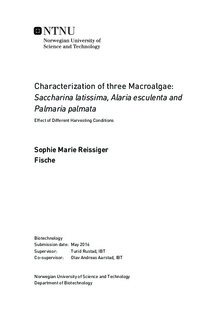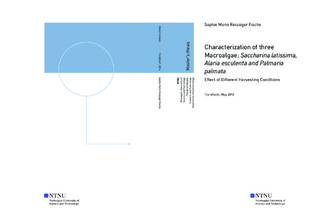| dc.description.abstract | Seaweeds have a long tradition of being a part of the diet in many Asian countries. In Europe seaweeds have mainly been utilized industrially, and especially for their content of phycocolloids, this includes Norway. Due to the dramatic increase in the world s population there is a demand for new food sources. However, the nutritional composition in macroalgae varies according to specie and environmental factors. Therefore, more knowledge on the chemical composition in the different macroalgal species is needed. In this thesis the chemical composition of Saccharina latissima, Alaria esculenta and Palmaria palmata was characterised. These are common macroalgal species growing on the Norwegian coast.
In order to characterize the composition of these macroalgae the dry matter, ash, total lipids, total protein and total carbohydrates were determined, in addition to the amino acid and carbohydrate composition. Different seasons and depths were examined in order to find the most optimal harvesting conditions. The P.palmata sample was a wild growing sample, while S.latissima and A.esculenta contained both cultivated and wild samples. The cultivated algae samples were harvested in May and June (S.latissima was also harvested in April), and from depths of 2, 5 and 8 meters. In addition, samples containing a mixture of these depths were analysed. The wild samples were harvested in June and contained samples with a mixture of different depths.
The protein content was found by determination of total nitrogen (the C/N method) and determination of the total amount of amino acids (by high-performance liquid chromatography, HPLC). Different hydrolysis methods were tried in order to see which gave the highest amino acid yields. Hydrolysis with 6M HCl containing 0.4% β-mercaptoethanol was found to give the highest yields. Determination of the carbohydrate composition in the macroalgae was performed by high-performance anion-exchange chromatography (HPAE). This method was optimized with regard to different hydrolysis times and different settings on the analysis instrument.
The highest dry matter content could be found in the wild growing samples of S.latissima and A.esculenta. In cultivated S.latissima the dry matter was highest in the samples harvested in May, while the dry matter content in cultivated A.esculenta was highest in June.
The ash content was highest in cultivated S.latissima and A.esculenta in May. The amount of lipids, proteins and carbohydrates were generally highest in cultivated S.latissima in May (except for the total carbohydrates), and in cultivated A.esculenta in June. Low lipid levels were found in all three macroalgae. When the samples were analysed by HPLC the results showed a higher protein content than when the samples were analysed by the C/N method. The protein content in S.latissima and A.esculenta was within the values reported in different literature for these species, while the protein content in P.palmata was low. The amino acid composition in S.latissima, A.esculenta and P.palmata was dominated by aspartic acid, glutamic acid, alanine and leucine. The carbohydrate content in S.latissima and A.esculenta was highest in the wild samples. The highest carbohydrate content in the cultivated samples could be found in April for S.latissima and in June for A.esculenta. The carbohydrate content was highest in P.palmata, which had a high amount of mannose/xylose and galactose. In S.latissima mannitol dominated the carbohydrate composition, while glucose dominated in A.esculenta, especially in the samples from June.
The different depths only provided small variations in the chemical content. However, some of the S.latissima and A.esculenta samples containing a mixture of depths had a lower dry matter and ash content and a higher content of lipids, proteins and carbohydrates, compared to the other samples. For example, the total protein content was twice as high in some of the samples containing a mixture of depths, than in the samples from individual depths. This was most likely because these samples were washed right after harvesting, and therefore salt and minerals could have been removed. | |

